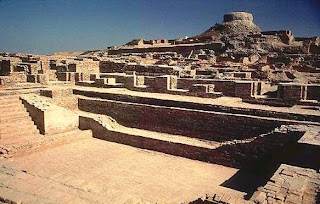 As the first civilisation of India, referred to as the Indus Valley or Harappan that existed from 2,600 B.C.E, this civilisation combined 3 major cities for a period that lasted for 100 years from 2600 - 1900 BCE. This period is known as the ‘Harappan Culture Integration Era’. The three major cities combined were Mohenjo-Dara, Harappa and Lothal.
As the first civilisation of India, referred to as the Indus Valley or Harappan that existed from 2,600 B.C.E, this civilisation combined 3 major cities for a period that lasted for 100 years from 2600 - 1900 BCE. This period is known as the ‘Harappan Culture Integration Era’. The three major cities combined were Mohenjo-Dara, Harappa and Lothal.These cities are located in modern Pakistan, and below is a brief outline of the importance of each city.
Mohenjo-Daro
•Mohenjo-Daro is one of the large settlements of the Indus Civilisation and the largest of the Harappan cities
•Mohenjo-Daro is protected by great fortifications and walls


•Social organisation and religious beliefs of Mohenjo-Daro remain anonymous; however, a small limestone figure from Mohenjo-Daro depicts a thick-lipped, bearded man staring at the world through slitted eyes. He seems to be meditating.
•However, by 1,800 B.C.E, the city of Mohenjo-Dara was abandoned. It is known that the city had become decentralised by then. A theory is that the river dried up, so there was no water, hence there was a population movement due to environmental changes.
•After 1,800, the Aryans from the North moved into Mohenjo-Dara. The Aryans are the modern Indians and Pakistan people today.
Harappa
•Harappa was also one of the large settlements of the Indus Civilisation, now modern Pakistan
•Harappan civilisation collapsed after 2000 BCE, and Harappa was abandoned (inhabitants were separated into village communities) due to disease such as malaria which led to population movement
Lothal
•Lothal was a vital and thriving trade centre trading beads, gems and valuable ornaments with West Asia and Africa.
• The people of this city, Lothal were responsible for the earliest-known portrayals of realism in art and sculpture, telling some of the most well-known fables of today
•The people of this city also pioneered the study of stars and advanced navigation—2000 years before the Greeks.
•For the next 4000 years, their techniques and tools they pioneered were still useful for bead-making and in metallurgy (study of the physical and chemical behaviour of metallic elements and the technology of metals such as metalworking).




 Ganguly; who was the best cricket player decided to retire. India’s one of the best captains, said that he will retire from the cricket after the India-Australia Series that is going to be held this month. Ganguly has brought many successes to Indian Cricket and India. Ganguly made India to be in the World Cup finals for the Second time. His enthusiastic sporting action and his aggressive nature in the field made a new style in the world of Cricket.
Ganguly; who was the best cricket player decided to retire. India’s one of the best captains, said that he will retire from the cricket after the India-Australia Series that is going to be held this month. Ganguly has brought many successes to Indian Cricket and India. Ganguly made India to be in the World Cup finals for the Second time. His enthusiastic sporting action and his aggressive nature in the field made a new style in the world of Cricket.